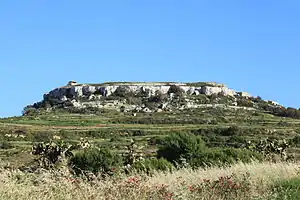Fort Binġemma
Fort Binġemma (formerly written as Fort Bin Jema[1] or Fort Bengemma,[2] Maltese: Il-Fortizza ta' Binġemma) is a polygonal fort in the limits of Rabat, Malta. It was built between 1875 and 1878 by the British as part of the Victoria Lines. The fort has been illegally occupied by the Buttigieg family since 2009, who occasionally use it as a restaurant.[3] It is set on a hill of around 590 feet above sea level. Previous to the building of the fort there used to be a Roman city or village.[4]
| Fort Binġemma | |
|---|---|
Il-Fortizza ta' Binġemma | |
| Part of the Victoria Lines | |
| Rabat, Malta | |
 Fort Binġemma as seen from Mġarr | |
| Coordinates | 35°54′12.4″N 14°21′45.2″E |
| Type | Polygonal fort |
| Site information | |
| Owner | Government of Malta |
| Controlled by | Buttigieg family |
| Open to the public | No |
| Condition | Intact but neglected |
| Site history | |
| Built | 1875–1878 |
| Built by | British Empire |
| In use | 1875–1970s |
| Materials | Limestone and concrete |
| Events | Albanian Subversion |
History
Fort Binġemma was built by the British as part of the Victoria Lines, a line of fortifications along the northern part of Malta, dividing it from the more heavily populated south. It is one of three forts built along the lines, the other two being Fort Madalena and Fort Mosta.[5]
Fort Binġemma is located at the western extremity of the line, and it was first of the forts to be built, with construction taking place between 1875 and 1878.[5] It has an irregular shape, and is protected by a cliff face to the north and a ditch to the south. It was armed with two 6-inch and one 9.2-inch breech-loading guns which had an arc of fire of 210 degrees, commanding the sea to the northwest and the ridges to the northeast.
Although the Victoria Lines were abandoned in 1907, Fort Binġemma, along with Fort Madalena, remained in use for coastal defence. From 1949 to about 1952, the fort was used to train Albanian insurgents fighting the communist regime in the Albanian Subversion.[3] It later became a communications centre for the 235 Signal Squadron.[6]
Present day
In 1981, the Government of Malta leased the fort to Gaetano Buttigieg for use as a pig farm. The lease expired in 1997, but it continued to be renewed annually until 2009. After the expiry of the lease, Buttigieg and his family continued to occupy the fort illegally, despite the government having the right to evict them. In 2011, he refused to let government officials enter the fort, which was guarded by an iron gate and dogs.[7]
Illegal development took place within the fort in 2013. In 2015, it was revealed that the fort was occasionally being used as a restaurant, which is also illegal. It is also used for cows and animal farming.[3]
References
| Wikimedia Commons has media related to Fort Bingemma. |
- Pearson, Owen (2006). Albania in the Twentieth Century, A History: Volume III: Albania as Dictatorship and Democracy, 1945-99. I.B.Tauris. p. 441. ISBN 9781845111052.
- Castillo, Dennis Angelo (2006). The Maltese Cross: A Strategic History of Malta. Greenwood Publishing Group. p. 135. ISBN 0313323291.
- Cordina, John (24 May 2015). "Squatters turn Fort Binġemma into illegal restaurant, family refuses compromise". The Malta Independent. Retrieved 29 May 2015.
- MacGill, Thomas (1839), "A handbook, or guide, for strangers visiting Malta", p.126-127.
- Spiteri, Stephen C. (22 October 2011). "Fort Mosta". MilitaryArchitecture.com. Archived from the original on 3 June 2017. Retrieved 29 May 2015.
- Lord, Cliff; Watson, Graham (September 2004). Royal Corps of Signals: Unit Histories of the Corps (1920-2001) and Its Antecedents. Helion & Company Limited. p. 96. ISBN 978-1-874622-92-5. Retrieved 29 May 2015.
- "Government blocked from retaking Fort Bingemma". Times of Malta. 14 April 2011. Retrieved 29 May 2015.